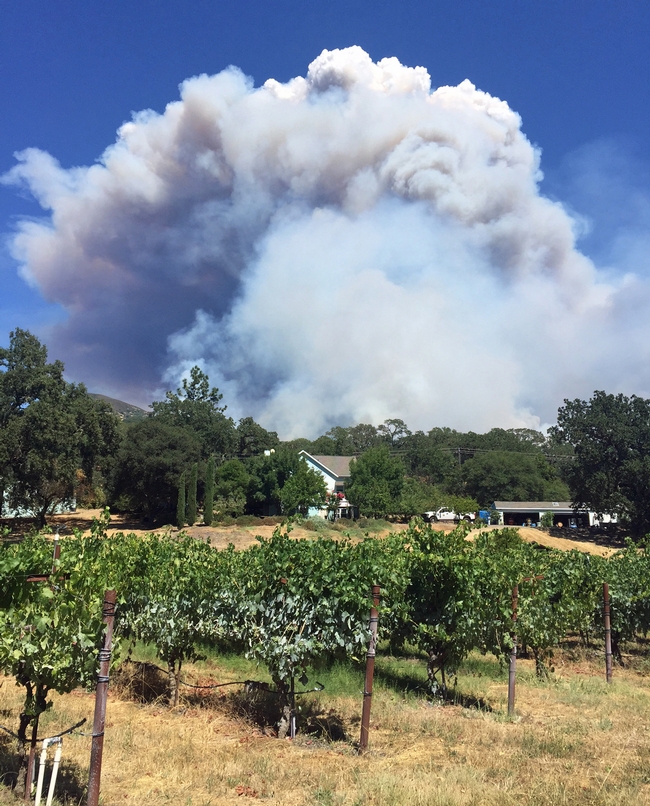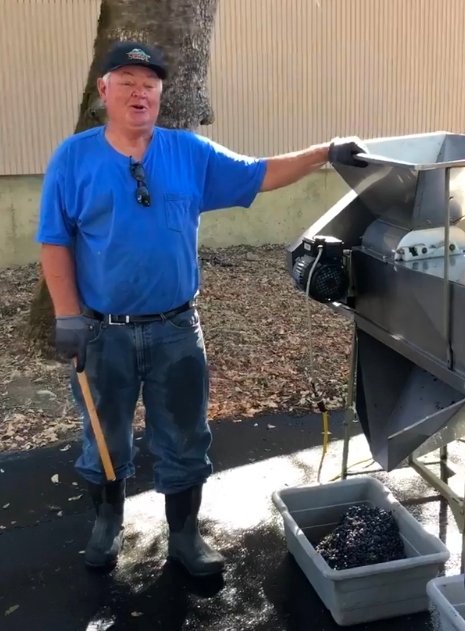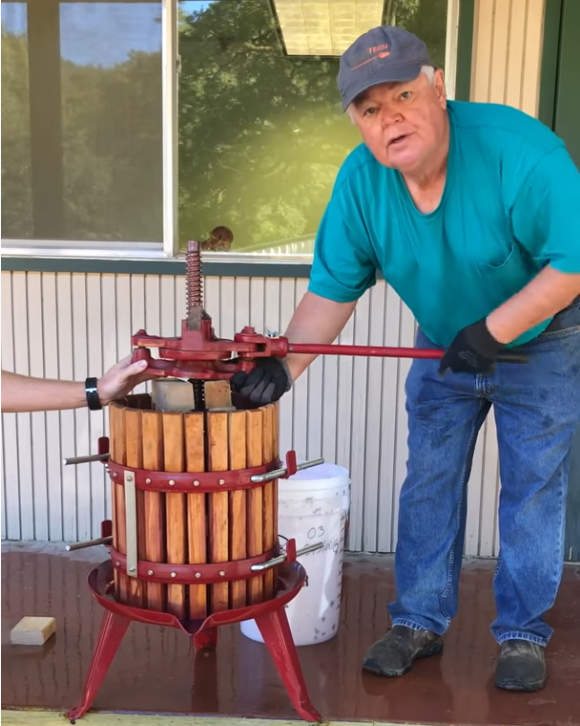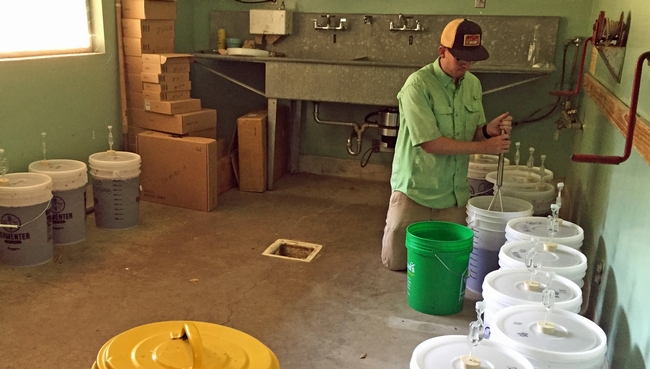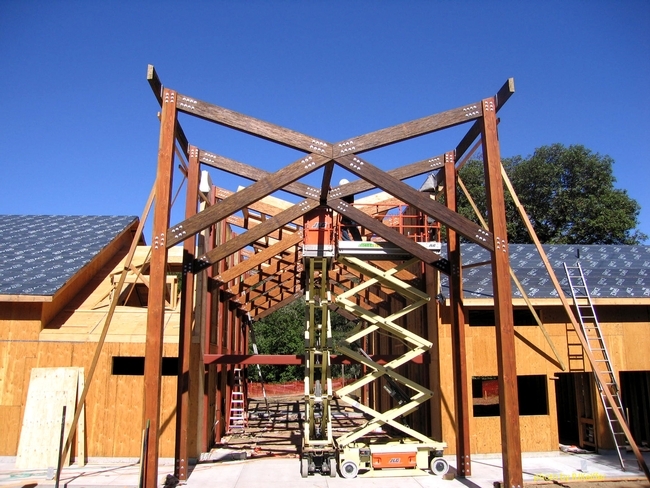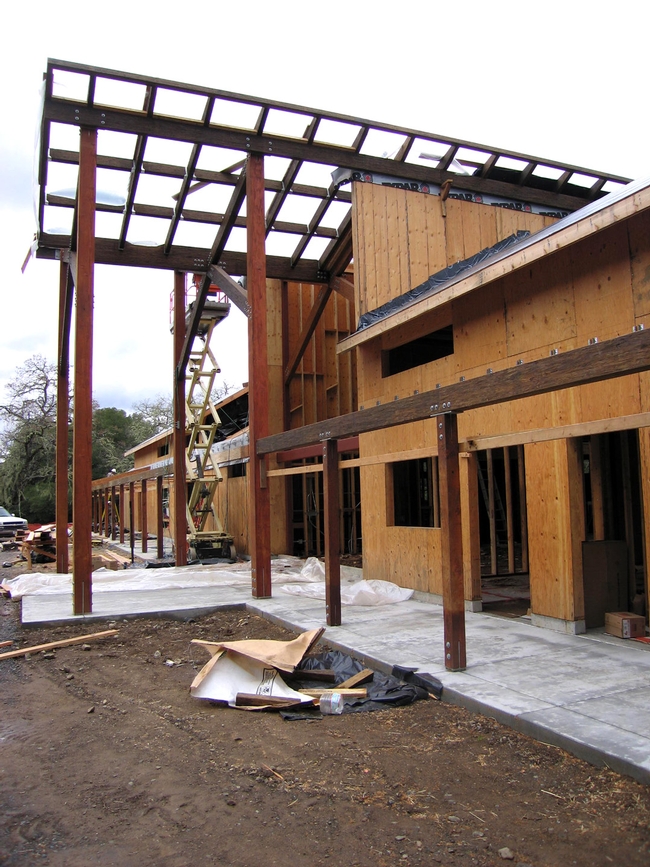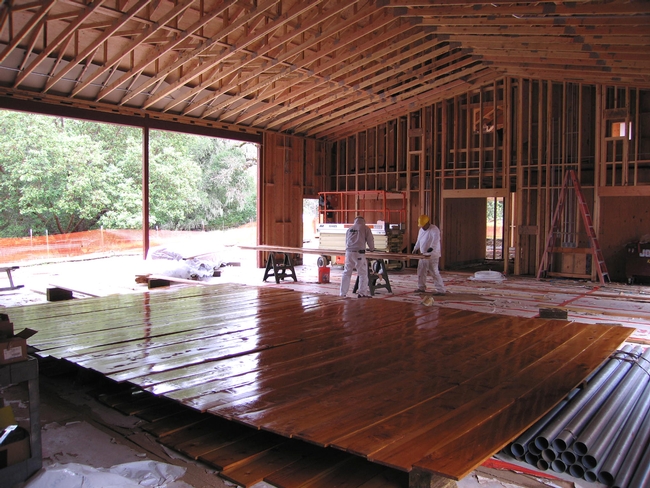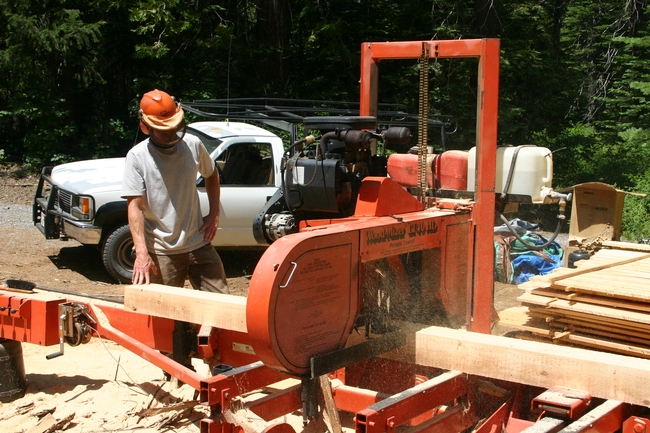Posts Tagged: Hopland Research and Extension Center
Where there is fire, is there smoke flavor in winegrapes?
UPDATED: Viticultural area is Kelsey Bench, not Kelseyville Bench.
UC Cooperative Extension study shows smoke damage to grapes not uniform across vineyards
By the time the Mendocino Complex Fires were officially contained on Oct. 4, 2018, five weeks after igniting, they had burned approximately 450,000 acres in Colusa, Lake, Glenn and Mendocino counties, making it the largest wildfire in California history, according to CalFire.
The fire not only destroyed 280 homes and other buildings, its smoke destroyed the market for wine grapes grown in vineyards near burned areas.
Fearing grapes near the fire would impart smoke flavors to the wine, some wineries rejected all fruit from nearby regions of Lake County and Potter Valley, leaving grape growers to hastily find new destinations for their 2018 crop.
“It can be difficult to determine if fruit has been compromised in quality when exposed to wildfire smoke, and whether or not smoke flavors will result in wine when fermented,” said Glenn McGourty, UC Cooperative Extension advisor in Mendocino County.
A new UC Cooperative Extension study shows wind direction and speed, temperature and a vineyard's proximity to an active fire are factors that can help growers and winemakers predict smoke damage to fruit.
“Fruit in my own vineyard, 60 feet across the street from where the fire started, had no smoke damage because the wind was blowing away from it,” McGourty said.
$41 million hit to wine grape sales
Due to the Mendocino Complex Fires, an estimated $41 million worth of winegrapes, which would have been sold at full price, were impacted – some were sold at a discount, some were sold to other customers, some were custom crushed, while some were left hanging in the vineyard, according to the Lake County Winegrape Commission and Mendocino County Farm Bureau.
The wine industry needed a scientific method of determining whether grapes could be made into a wine untainted by smoke. With funding from the Lake County Winegrape Commission, McGourty formed a workgroup of local growers and winemakers with Anita Olberholster, UC Cooperative Extension enology specialist in the Department of Viticulture & Enology at UC Davis, to research when fruit quality has been compromised.
“The need for industry standards regarding the impact of wildland smoke on winegrapes and the resulting wines has become even more pressing over the past few years,” said Debra Sommerfield, president of the Lake County Winegrape Commission.
Science showed the intensity, duration and timing of the exposure to wildfire smoke affects the grape's uptake. Generally, the closer to harvest, the greater risk to the fruit.
“Both the fruit and wine samples in our study showed a wide range of volatile phenol and glycocide concentrations, indicating that smoke damage to fruit was not uniform across the vineyards sampled,” McGourty said.
Volatile phenols and glycosides create off-flavors
Fresh smoke contains volatile phenols and glycosides that can affect fruit, but these chemicals tend to dissipate in the atmosphere in 1 to 2 hours. Vineyards close to actively burning fires and in the path of fresh smoke are most likely to be affected by smoke taint. Smoke that travels long distances is less likely to affect grapes and the wine made from the fruit.
The combination of volatile phenols and glycosides create “smoke taint” – both aromatic and tactile in the mouth. Wine drinkers may smell smoke or other off flavors and experience a drying of their mouth when high concentrations of the chemicals are present in wine.
“At lower concentrations, smoke taint reminds you of brett-affected wines,” Oberholster explained, referring to the yeast brettanomyces. “There is a shortness of fruit, a kind of dryness in the mouth that you know isn't normal. There may be barely perceptible aromas that aren't normal as well.”
Following wildfire smoke exposure, the researchers sampled fruit from 14 cabernet sauvignon vineyards around the viticultural areas of Lake County, including Upper Lake, High Valley, Big Valley, Kelsey Bench, Red Hills, Lower Lake and Guenoc Valley. As a control, fruit was also sampled from a Napa Valley vineyard that was not exposed to wildfire smoke.
“The volatile phenols guaiacol and 4-methyl guaiacol are detected in the fruit by gas chromatography, so it is possible to sample fruit before harvest to make picking decisions,” McGourty said. “Based on our study, berry sampling and guaiacol/ 4-methyl guaiacol analysis are useful for a quick evaluation of whether or not fruit from a particular vineyard may have the presence of volatile phenols that can potentially result in smoke-affected wine.”
Testing the fruit for volatile phenols and glycosides is both expensive and not completely predictive as standards are not well defined for damage based on smoke chemical concentration, he cautioned.
These two compounds aren't the only ones that cause smoke flavors. More than 70 other compounds in forest fire smoke can also produce undesirable flavors and odors described as “like licking an ash tray, burnt garbage, a burnt potato, a campfire that has been drenched with water.”
The taste test
To assess the levels of the compounds that produce the off-flavors, Oberholster convened a panel of 14 wine industry professionals to taste the sample wines. The wine tasters detected stronger off-flavors in the wines made from riper fruit, which also contained higher concentration of smoke compounds. Less than 6 micrograms per liter of the smoke compounds were difficult for the tasters to detect, leading the researchers to conclude they will have a minimal effect on wine quality.
Smoke from a distant fire
The scientists also looked at the influence of distance from the fire and elevation on smoke taint. They found some vineyards close to the edge of fires and immediately downwind were heavily affected, with the grapes containing high concentrations of the smoke flavor-causing compounds. But they determined elevation was not a factor in smoke flavors in wines.
Wind direction and speed, temperature and vineyard proximity to active fires are highly likely affect whether there will be smoke damage to the fruit, their research showed.
“Smoke generated in the first one or two hours from a wildfire is most damaging to nearby vineyards,” McGourty said. “Even though a vineyard may be enveloped in smoke, if the source of the smoke is from a distant fire, it will probably won't seriously damage the fruit quality because most of the volatile gases are gone.”
Lake County Winegrape Commission's Sommerfield said, “Today, the results of this study are already proving to be useful in deepening our understanding of smoke and the risks it poses to grapes and wine, in enabling grape growers and winery buyers to engage in fruitful discussions and make informed decisions, and, in turn, in helping to propel the development of industry standards and protocols.”
To read more about the study by McGourty, Michael I. Jones, Oberholster and Ryan Keiffer, see the January 2020 edition of Wine Business Monthly at https://www.winebusiness.com/wbm.
“This is a great little study, the first one that I know of that takes a systems approach to evaluating the effects of wildfire smoke,” said McGourty.
Glenn McGourty, UCCE viticulture advisor for Mendocino County, describes for Hannah Bird the UC project to analyze the effect of wildfire smoke on winegrapes.
New Hopland building integrates nature with function
Woodpecker-friendly siding harvested from a UC-managed forest and posts salvaged from a century-old mill are among the many “green” features at a new University of California facility currently under construction in Mendocino County.
The new Rod Shippey Educational Facility and Field Laboratory at the UC Hopland Research and Extension Center is currently under construction, scheduled for completion in June. The facility is being constructed to meet standards equivalent to Leadership in Energy and Environmental Design (LEED) certification, per University of California requirements of new buildings.
“We want this building to be educational itself,” said Bob Keiffer, superintendent of the UC Hopland Research and Extension Center. “We are trying every which way possible to incorporate ‘green aspects’ into this building.”
As early as October the building will welcome visitors to learn about natural resources, agriculture and science. It is expected to comfortably seat 180 to 200 people.
“We envision this building as being used by the entire community of the North Coast. There’s no other large meeting facility of this kind in Mendocino County that we know of and that will have this connection to the outdoors,” Keiffer said.
Community members are also contributing to the project. Six 27-foot tall reclaimed Douglas fir posts will greet visitors at the entry of the Rod Shippey Facility, a feature made possible in part to a donation by North Cal Wood Products, a Ukiah company that specializes in reclaimed and recycled wood. These posts, with 13 smaller timbers along the breezeway, have been reclaimed from the Pacific Lumber Company mill in Scotia, once the largest redwood mill ever constructed.
“We went out to the yard and saw them slice open the first timber,” said Shawn Tibor, director of facilities for UC Agriculture and Natural Resources. “With the timbers being 100 years old from another structure, we had to decide on-site where to position each post’s face. They have character, let’s put it that way. But all of them are standing now and have been stained.”
The Penofin wood stain was donated by another Ukiah company, Performance Coatings.
Woodpeckers welcome
“We have one of the densest populations of acorn woodpeckers anywhere in the state. The woodpeckers form granaries where they store acorns, sometimes in trees — and sometimes in buildings,” Keiffer said. “They can actually be quite destructive, with a series of half-inch holes all over the place.”
Impervious siding seemed like a requirement for the new building, until designers praised the weathered characteristics of historic barns on the property.
“We really tried to design this building so that it ties people to the natural world,” Keiffer said. “We want a very close relationship between the building and what’s outside—and the acorn woodpecker is a major part of that.”
So the building materials actually encourage woodpeckers to make use of the building. Cedar siding, soft enough to welcome woodpeckers, was sourced from UC Berkeley’s Blodgett Forest Research Station and fitted to a waterproof membrane that will help further protect the building.
First UC building with siding from a UC-managed forest
No other University of California building has sourced wood directly from the Blodgett Forest before, according to Robert York, research stations manager with the Center for Forestry at UC Berkeley.
The Blodgett Forest in the Sierra Nevada near Georgetown in El Dorado County, is harvested each year in the context of the station’s research, usually with contractors harvesting the trees and commercial sawmills purchasing the logs. Tracking wood from a single forest through a commercial mill would be difficult, so instead logs for the Hopland facility’s 7,500 board-feet of 1-inch siding went to the station’s own small sawmill, which is more commonly used for educational demonstrations.
“It was actually me out there doing most of the milling of the siding,” York said.
“I think it does represent the kind of collaboration that we can have between research sites in California,” York said. “We're all trying to improve ways of managing and understanding natural resources. Whether it's a forest or a grassland, we all have this objective that's shared between us.”
Efficiency within a narrow budget
Plans for the building have evolved when it comes to funding, efficiency and green design. The building was originally slated for $1.7 million capital funding in the state’s 2007 budget, which was later frozen until January 2010. Private donations, including an anonymous $750,000 pledge, have helped make the building a reality.
Budget restrictions have meant cutting back on some of the more innovative systems that could further lower heating costs, reduce water needs and improve the building’s overall eco-friendliness. Passive heating, cooling and indoor-comfort measures have been implemented in the meantime, and construction has moved forward keeping as many other options open as possible. For example, the building’s restrooms are plumbed with separate grey-water and black-water pipes, which would make plans for on-site black-water treatment more feasible in the future.
“We’re situated so that if next year we get funded for something more integrative or progressive, the possibilities remain,” Tibor said. “There’s no limit to great, innovative ideas; it’s the budget that drives things.”
Get construction update and more details about green features at the facility's website http://ucanr.org/sites/Rod_Shippey_Facility.

